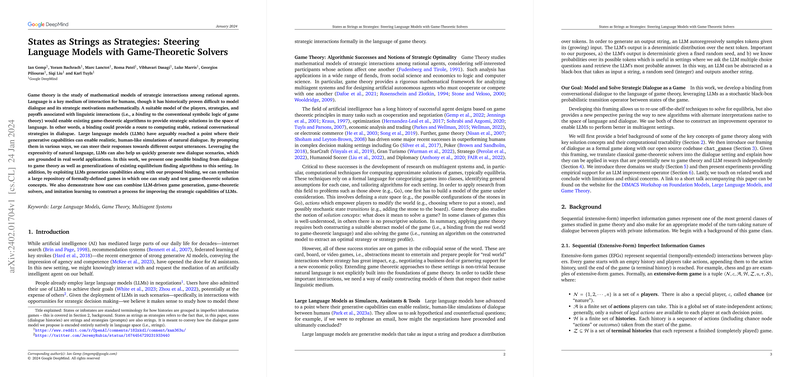Background and Objectives
The intricate relationship between strategic human interactions and language has long been acknowledged, yet formalizing this relationship within a game-theoretic framework continues to present a unique challenge. This paper introduces a novel approach that integrates the generative capabilities of LLMs with the strategic analysis of game theory, aiming to compute stable, rational strategies in conversational dialogue. By considering language as a strategic tool, LLMs are not only seen as agents capable of realistic dialogue simulations but are also recognized for their utility in generating fresh dialogue scenarios grounded in real-world applications.
Game-Theoretic Integration with LLMs
The paper's central contribution is the establishment of a "binding" from conversational dialogue to the language of game theory, thereby reframing dialogue as a formal game. This opens the door for leveraging existing game-theoretic algorithms to solve strategic interactions represented in the space of language. Furthermore, by drawing on the generative prowess of LLMs, the authors propose and implement generalizations of equilibrium finding algorithms for the dialogue setting. This novel intersection provides insightful perspectives for further algorithm development inherently suited for language and dialogue spaces.
Another significant aspect of the paper is the method through which LLMs aid in quickly synthesizing formal games. This large repository allows for rigorous paper and testing of game-theoretic solution concepts. Crucially, the combination of LLM-driven game generation, game-theoretic solvers, and imitation learning formulates a process to enhance LLMs' strategic capabilities in multi-agent environments.
From Theoretical Framing to Practical Application
Practical considerations are addressed by implementing the theoretical framework into an open-source codebase, chat_games, enabling researchers and practitioners to model their dialogue games and solve them using established game-theoretic solvers. The provision of dialogue as a formal game involves defining actions as strings to influence LLM output and modeling payoffs, which in certain cases directly map onto real-world outcomes, such as monetary value in a business negotiation. This practical translation from theory to application further emphasizes the operational versatility of this approach.
Empirical Strength and Implications
Empirical validation of the proposed methodology demonstrates the potential for strategic improvement of LLMs. The experiments entail using game-theoretic solvers as improvement operators, revealing that the use of algorithms like counterfactual regret minimization (CFR) and policy-space response-oracles leads to policy enhancement when compared against baseline LLM strategies. Extensive testing within the paper's defined domains, such as scheduling meetings or trading fruit, provide robust support for the authors' claims.
In conclusion, this research delineates a valuable intersection between game theory and LLMs, furnishing both a conceptual and practical framework that could redefine how we anticipate and construct strategic behavior in conversational AI. With significant numerical results validating improvement operators in LLMs, the paper offers a profound inception point for future research aimed at optimizing strategic discourse in numerous domains.
